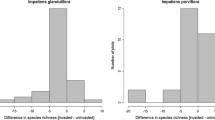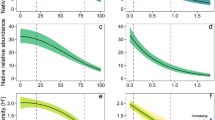Abstract
While the effects of an invasive alien plant that has become dominant in a community may seem obvious, there are few studies that attempt to understand how impacts vary according to the characteristics of invaders and recipient communities. For this purpose, the vegetation of invaded and non-invaded plots was sampled for eight different invasive species in a variety of habitats within the French continental Mediterranean region. Most of the observed impact variation was species-specific, with greater effects on community-level metrics found for Carpobrotus spp. and Reynoutria × bohemica and lower effects for Amorpha fruticosa, Ambrosia artemisiifolia and Phyla filiformis. Some trends were consistent with competition-driven processes, with higher impact found in the presence of rhizomatous and creeping perennial invasive species compared to annuals, or in habitats with sparse vegetation. The importance of community characteristics such as the cover of the invasive plant or the differences in cover between the invader and the native dominant species confirmed previous results obtained in Central Europe. Therefore, such variables, easy to measure and with a generic value, could be profitably integrated into risk assessment methods to improve the prediction of the most threatened habitats. Beyond the overall decline in species diversity, the presence of some invasive species was associated with significant changes in species composition, with a filtering toward more shade-tolerant and nitrophilous ruderal species. Managers should consider replacement of resident species by species with different ecological preferences together with simple community-level metrics, to decide whether management is justified.




Similar content being viewed by others
References
Amigo J-J (1983) Contribution à l’étude de la flore du département des Pyrénées-Orientales Le Monde des Plantes 413:3
Anderson MJ (2001) A new method for non-parametric multivariate analysis of variance. Austral Ecol 26:32–46
Brunel S, Schrader G, Brundu G et al (2010) Emerging invasive alien plants for the Mediterranean Basin. EPPO Bull 40:219–238
Byun C, de Blois S, Brisson J (2013) Plant functional group identity and diversity determine biotic resistance to invasion by an exotic grass. J Ecol 101:128–139
Caño L, Campos JA, García-Magro D et al (2013) Replacement of estuarine communities by an exotic shrub: distribution and invasion history of Baccharis halimifolia in Europe. Biol Invasion 15:183–186. doi:10.1007/s10530-012-0360-4
CBNMed (2011a) Espèces Végétales Exotiques Envahissantes en Languedoc-Roussillon et Provence-Alpes-Côte-d’Azur. Conservatoire Botanique national méditerranéen de Porquerolles. http://www.invmed.fr/liste_noire. Accessed 26 Feb 2011
CBNMed (2011b) SILENE, Système d’Information et de Localisation des Espèces Natives et Envahissantes. Conservatoire Botanique national méditerranéen de Porquerolles. http://flore.silene.eu/index.php?cont=accueil. Accessed 26 Feb 2011
Chauvel B, Cadet E (2011) Introduction and spread of an invasive species: Ambrosia artemisiifolia in France. Acta Bot Gallica 158:309–327
Chesson P (2000) Mechanisms of maintenance of species diversity. Annu Rev Ecol Syst 31:343–366
Chevan A, Sutherland M (1991) Hierarchical partitioning. Am Stat 45:90–96
Chytrý M, Maskell LC, Pino J et al (2008) Habitat invasions by alien plants: a quantitative comparison among Mediterranean, subcontinental and oceanic regions of Europe. J Appl Ecol 45:448–458
Cornelissen JHC, Lavorel S, Garnier E et al (2003) A handbook of protocols for standardised and easy measurement of plant functional traits worldwide. Aust J Bot 51:335–380
Davis MA, Grime JP, Thompson K (2000) Fluctuating resources in plant communities: a general theory of invasibility. J Ecol 88:528–534
Diekmann M (2003) Species indicator values as an important tool in applied plant ecology - A review. Basic Appl Ecol 4:493–506
Emery SM, Gross KL (2006) Dominant species identity regulates invasibility of old-field plant communities. Oikos 115:549–558
Everard K, Seabloom EW, Harpole WS et al (2010) Plant water use affects competition for nitrogen: why drought favors invasive species in California. Am Nat 175:85–97
Gaertner M, Den Breeyen A, Hui C et al (2009) Impacts of alien plant invasions on species richness in Mediterranean-type ecosystems: a meta-analysis. Prog Phys Geogr 33:319–338
Godoy O, Valladares F, Castro-Díez P (2012) The relative importance for plant invasiveness of trait means, and their plasticity and integration in a multivariate framework. New Phytol 195:912–922
Grime JP (1998) Benefits of plant diversity to ecosystems: immediate, filter and founder effects. J Ecol 86:902–910
Grime JP (2006) Trait convergence and trait divergence in herbaceous plant communities: mechanisms and consequences. J Veg Sci 17:255–260
Hejda M (2012) What is the impact of Impatiens parviflora on diversity and composition of herbal layer communities of temperate forests? PLoS One 7 (6), art. no. e39571
Hejda M, Pyšek P (2006) What is the impact of Impatiens glandulifera on species diversity of invaded riparian vegetation? Biol Conserv 132:143–152
Hejda M, Pyšek P, Jarošik V (2009) Impact of invasive plants on the species richness, diversity and composition of invaded communities. J Ecol 97:393–403
Hothorn T, Hornik K, Zeileis A (2006) Unbiased recursive partitioning: a conditional inference framework. J Comput Graph Stat 15:651–674
Hulme PE (2012) Weed risk assessment: a way forward or a waste of time? J Appl Ecol 49:10–19
Hulme PE, Pyšek P, Jarošík V et al (2013) Bias and error in understanding plant invasion impacts. Trend Ecol Evol 28:212–218. doi:10.1016/j.tree.2012.10.010
Julve P (1998) Baseflor. Index botanique, écologique et chorologique de la flore de France. Version : “4 mars 2012”. http://perso.wanadoo.fr/philippe.julve/catminat.htm. Accessed 21 March 2012
Levine JM, Vilà M, D’Antonio CM et al (2003) Mechanisms underlying the impacts of exotic plant invasions. Proc R Soc Lond Ser B Biol Sci 270:775–781
Levine JM, Adler PB, Yelenik SG (2004) A meta-analysis of biotic resistance to exotic plant invasions. Ecol Lett 7:975–989
Maron JL, Marler M (2008) Effects of native species diversity and resource additions on invader impact. Am Nat 172:S18–S33
Maurel N, Salmon S, Ponge JF et al (2010) Does the invasive species Reynoutria japonica have an impact on soil and flora in urban wastelands? Biol Invasions 12:1709–1719
Muller S (2004) Plantes invasives en France. Muséum National d’Histoire Naturelle, Paris
Olden JD (2006) Biotic homogenization: a new research agenda for conservation biogeography. J Biogeogr 33:2027–2039
Powell KI, Chase JM, Knight TM (2011) A synthesis of plant invasion effects on biodiversity across spatial scales. Am J Bot 98:539–548
Pyšek P, Jarošík V, Hulme PE et al (2012) A global assessment of invasive plant impacts on resident species, communities and ecosystems: the interaction of impact measures, invading species’ traits and environment. Glob Change Biol 18:1725–1737
Raunkiaer C (1934) The life forms of plants and statistical plant geography. Clarendon press, Oxford
Reever MKJ, Rice KJ (2006) Variation in resource availability changes the impact of invasive thistles on native bunchgrasses. Ecol Appl 16:528–539
Richardson DM, Pyšek P, Rejmánek M et al (2000) Naturalization and invasion of alien plants: concepts and definitions. Divers Distrib 6:65–112
Santoro R, Jucker T, Carranza M et al (2011) Assessing the effects of Carpobrotus invasion on coastal dune soils. Does the nature of the invaded habitat matter? Community Ecol 12:234–240
Smith MD, Wilcox JC, Kelly T et al (2004) Dominance not richness determines invasibility of tallgrass prairie. Oikos 106:253–262
Tilman D (2004) Niche tradeoffs, neutrality, and community structure: a stochastic theory of resource competition, invasion, and community assembly. Proc Natl Acad Sci USA 101:10854–10861
Underwood EC, Viers JH, Klausmeyer KR et al (2009) Threats and biodiversity in the mediterranean biome. Divers Distrib 15:188–197
Vilà M, Tessier M, Suehs CM et al (2006) Local and regional assessments of the impacts of plant invaders on vegetation structure and soil properties of Mediterranean islands. J Biogeogr 33:853–861
Vilà M, Espinar JL, Hejda M et al (2011) Ecological impacts of invasive alien plants: a meta-analysis of their effects on species, communities and ecosystems. Ecol Lett 14:702–708
Violle C, Garnier E, Lecoeur J et al (2009) Competition, traits and resource depletion in plant communities. Oecologia 160:747–755
Weber E, Gut D (2004) Assessing the risk of potentially invasive plant species in central Europe. J Nat Conserv 3:171–179
Zeiter M, Stampfli A (2012) Positive diversity-invasibility relationship in species-rich semi-natural grassland at the neighbourhood scale. Ann Bot 110:1385–1393
Acknowledgments
We gratefully acknowledge financial support by the French Agency for Food, Environmental and occupational Health & Safety (ANSES) for allowing MSc grants to NC (2011) and CP (2012). We thank Isabelle Mandon-Dalger (FCBN) for fruitful discussion, Claire Tetrel (Domaine de la Palissade), Luc Capon (Communauté de communes de la Cévenne des Hauts Gardons), Benjamin Sirot (CEN-LR) and Jean-Philippe Reygrobellet (SMAGE des Gardons) for their kind permission of access to some study sites, as well as to Jean-Marie Ramel, Jean-Claude Streito and Philippe Reynaud (Anses) for their assistance in the field. The authors are also grateful to two anonymous reviewers for valuable comments.
Author information
Authors and Affiliations
Corresponding author
Appendices
Appendix 1
See Table 5.
Appendix 2
See Table 6.
Appendix 3
See Table 7.
Rights and permissions
About this article
Cite this article
Fried, G., Laitung, B., Pierre, C. et al. Impact of invasive plants in Mediterranean habitats: disentangling the effects of characteristics of invaders and recipient communities. Biol Invasions 16, 1639–1658 (2014). https://doi.org/10.1007/s10530-013-0597-6
Received:
Accepted:
Published:
Issue Date:
DOI: https://doi.org/10.1007/s10530-013-0597-6




